Walk 636 - Hannington, Cottington's Hill and Bluebells

Following the Wayfarer's Walk through Stubbington Farm.
When we pre-walked (did the recce for) this walk a couple of weeks ago, it was sunny but very muddy underfoot. There were also a lot of bluebells in flower. On Saturday 27th April, when we led the walk for twelve people (including a newcomer trying us out) the weather was very dull and grey. On the plus side, it wasn't windy, it didn't rain, the paths were less muddy and the bluebells were still in flower.
We started from the car park on White Hill and immediately began following the Wayfarer's Walk south-eastward. After the steep climb past Stubbington Farm, we had a slow descent from Walkeridge Farm to the hamlet of North Oakley.

One of the many patches of bluebells in Frith Wood.
We continued to follow the Wayfarer's Walk, as it passed through The Manor Farm and Freemantle Farm. On reaching Frith Wood, we were greeted by a spectacular display of bluebells. Even better than during our pre-walk.
It seems that no matter how impressive the bluebells look to the naked eye, the camera always struggles to do them justice. Nevertheless, most of us took photos when we stopped (on several occasions) to admire them.

The Wayfarer's Walk between Frith Wood and Patchbourne Wood.
Leaving Frith Wood, we crossed a field into Patchbourne Wood where we saw more bluebells, mixed with wood anemones, celandines and other woodland flowers.
We left the Wayfarer's Walk and followed White Lane to a crossroads where we joined Hannington Road. We left this road on reaching a finger-post signpost with a wellington boot attached to it, signifying that we'd joined the Welly Boot Corner Walk. This interestingly-named local walk took us through the woodland of Hay Wood and Warren Bottom Copse, which were also home to many more bluebells.

The Hannington transmitter mast on Cottington's Hill.
We stopped by Sheeplane Plantation and sat on a dry corner of a field for lunch. Although we hadn't seen any sun today, the wind was gentle as we ate our packed lunches and chatted.
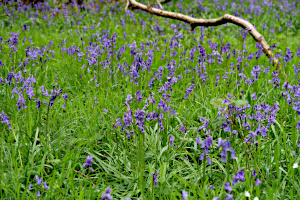
More bluebells at Warren Bottom Copse.
After lunch, we continued following the Welly Boot Corner Walk to its end at the village of Hannington. When leading this walk in previous years, we've stopped for a drink at The Vine, but this has sadly closed, like many country pubs have done in recent years.
From Hannington, we followed Meadham Lane, then an unnamed lane that took us up to Cottington's Hill and the transmitter mast. Now at the highest point on the walk, we descended through Stubbington Down and back to the White Hill car park from where we'd started. See our route on Google Maps.
Thanks go to Emma and Rob for leading this walk and Rob for the write-up.
Walk 635 - Maidensgrove and Nettlebed
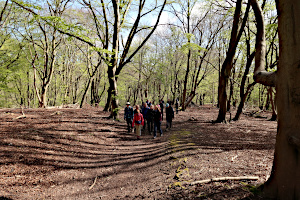
Walking through woodland in Warburg Nature Reserve.
Seventeen of us headed off from a sunny and breezy start on Maidensgrove Common in the Chiltern Hills on Saturday 20th April. Being fairly high ground in South Oxfordshire it's often a windy spot - with plenty of parking usually available. It was good to welcome some new members on this walk, and lovely to have see recent joiners out with the group again, as well as our longstanding members.

One of the many bluebell-lined paths around Nettlebed.
We began by walking downhill into the Warburg Nature Reserve, managed by Berkshire, Buckinghamshire & Oxfordshire Wildlife Trust.
This was shortly followed by a climb up the other side of the valley, watching the squirrels among the trees. Crossing parkland near Crocker End, as we approached Nettlebed, happily there were carpets of bluebells and wild garlic to be seen.

A heard of deer near Redpits Manor.
The Cheese Shed café was our next point of call - for coffee and cake to refuel after the climb uphill. Some of us also popped in to St Bartholmew's church to see the nature themed stained glass windows designed by John Piper.

A bluebell-lined path in Russell's Water.
Leaving Nettlebed, it was lovely to find yet more bluebells flowering as we headed towards Park Corner. A large herd of deer were also seen in the fields near Redpits Manor as we approached our lunch spot. Fallow or Roe deer? We weren't sure which!
After lunch, we continued along the valley, followed by a slow and steady climb back up the hill to Russell's Water. Taking a path initially through the bracken, then back across the wide open expanse of Maidensgrove Common to return to our start point. See our route on Google Maps.
Thanks go to Ruth for leading this walk and for writing it up. (Photos by Rob C)
Walk 634 - Finchampstead Bluebell Evening Walk
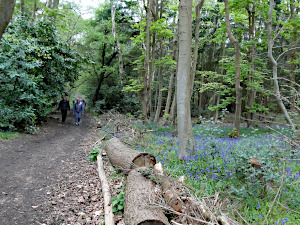
Walking through Coalpit Copse.
Our first midweek evening walk of the year was on Thursday 18th April. Starting at 6.45pm from the NT Simon’s Wood car park in Finchampstead, sixteen Ramblers set off in search of bluebells and they weren’t disappointed. Heading south from the car park, we took the path down through Simons Wood to Coalpit Copse, where the woodland on both sides of the path was a carpet of deep blue and appeared even more vibrant compared to the same woodland this time last year. At the bottom of Coalpit Copse, we turned right onto Ambarrow Lane in the direction of the Moor Green Lakes. After skirting around the edge of Horseshoe Lake we joined the Blackwater Valley Path past Grove Lake, following the meandering Blackwater River.
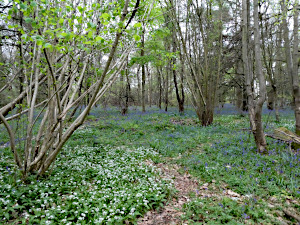
Bluebells and Wild Garlic in Simons Wood.
On leaving the Blackwater Valley Path, we headed north through the nature reserve past Colebrook Lake South and Colebrook Lake North, both of which are popular for bird watching, the small islands in them being named Snipe, Sandpiper, Tern, Goose and Plover Islands. On reaching the road, we continued north along Dell Road, admiring the attractive thatched cottages and beautiful spring flowers, before taking a path to the NT Finchampstead Ridges. To make the most of the fading daylight, we took paths through some of the more open woodland, before a short relatively steep ascent up to the ridge and Wellingtonia Avenue. We followed a path parallel to the road back through Simons Wood to the car park, finishing the 3.6 mile walk at 8.07pm, just three minutes after the sun had begun to set.
Thanks go to Sue B for leading this walk, providing the photos and writing it up.
Walk 633 - Swallowfield, Farley Hill and Blackwater River
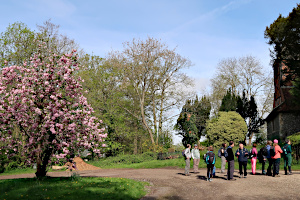
Standing outside All Saints church, Swallowfield.
Saturday 13th April was the perfect spring day – plenty of sunshine, blossom and birdsong. Following a couple of weeks of heavy rain, the warmer weather this weekend enticed nineteen walkers (including three new walkers trying out the BWWs) to join us for a 6.6 mile walk, starting from the Parish Hall in Swallowfield.
We set off through Swallowfield Park, following the River Broadwater to the thirteenth century church of All Saints, passing the river flood monitoring station on the way.

Bluebells of blue, white and pink in All Saints churchyard.
The churchyard was full of spring flowers, including our first glimpse of bluebells and forget-me-nots. On leaving the pretty church-yard, we encountered our first section of mud as we passed through a gate before heading north east along a much dryer path between hedgerows.
Following the recent rain, the fields beyond the hedges were partly flooded and a flock of Egyptian Geese, together with a lapwing were making the most of the shallow ponds that had been created.

The River Broadwater at the confluence of the rivers Whitewater and Blackwater.
We then turned onto a path heading south towards the George and Dragon pub, after which we walked along Nutbean Lane, before turning right onto a footpath just past Wheeler’s Farm. Here, we had to negotiate another muddy section and those with walking poles were at a distinct advantage.

The path was badly flooded approaching Wheeler's Copse.
Fortunately, the next section of the route was very much dryer through the water meadows next to the Broadwater River and it wasn’t long before we passed where the Broadwater divides into the Whitewater and Blackwater Rivers. Apparently, in summer, after low rainfall, the Whitewater can hardly be seen.
On reaching the Ford near Jouldings Farm, we followed a track northwest towards Wheeler’s Copse. A small section of this track is often flooded during the winter months and local walkers have established a short diversion through a neighbouring field, which we made good use of, having found the flooded track totally unpassable.

A sea of bluebells at Wheeler's Copse.
On reaching Wheeler’s Copse, there was the most magnificent carpet of bluebells for us to admire. From here, we walked north along Sandpit Lane to Farley Hill, where there were flowering cherry trees in full bloom and we were accompanied by the sound of pheasants.

Cherry Blossom at Farley Hill.
Continuing north towards Farley Castle, we then headed west towards New Plantation, which was our lunch stop, with plenty of fallen trees for everyone to sit on and a few more bluebells.
After lunch, we headed west along the edge of the plantation and then re-entered Swallowfield Park, where there was a magnificent row of old oak trees. It wasn’t long before we rejoined our outward path through the park, past the church and back to the Parish Hall. See our route on Google Maps.
Thanks go to Sue B for leading this walk and writing it up. (Photo by Rob C)
Walk 632 - Pinkneys Green, Hurley and Temple
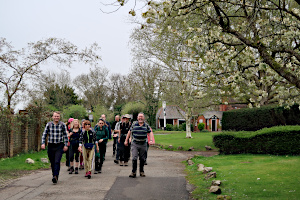
Walking through Burchett's Green.
On Saturday 6th April, seventeen of us, including a couple of people trying us out, met up in the NT car park at Pinkneys Green, near Maidenhead. Our leader for this walk was Neil, who explained that he may have to modify the route if the paths by the River Thames were still impassable. These paths had been flooded a few weeks earlier.
We set off across a grassy field full of cowslips before crossing the A404 dual carriageway on a footbridge on our way to Maidenhead Thicket. Passing Stubbing's House and garden centre, we arrived at Burchett's Green.

Entering the Berkshire College of Agriculture.
We walked through this pretty village and into the grounds of Berkshire College of Agriculture, firstly crossing their playing fields and then following a footpath through the maze of college buildings. This path used to pass through the BCA Zoo, but has been moved in recent years, so we didn't get a look at the animals this time.
Leaving the Berkshire College of Agriculture, we headed through fields and uphill to High Wood on Prospect Hill. A steep downhill path the other side brought us to Hurley.

Walking by the Thames at Hurley Lock.
We walked along Hurley High Street to the River Thames, where we crossed onto an island separating the river into two branches, one passing through Hurley Lock and the other through a weir. We stopped by the lock for lunch.
After lunch, we walked along the previously flooded paths by the Thames, which were now quite passable. These took us too Temple and then on to Bradenham Lane. A permissive path took us alongside the A404 to Temple Golf Course, where we passed under the A404 in a pedestrian tunnel.

The war memorial in Dungrovehill Wood.
We followed Dungrove Hill Lane uphill and entered Dungrovehill Wood. Here Neil showed us a small war memorial, consisting of a deep trench and a number of allied airforce flags. On 18th July 1944, a Halifax heavy bomber aircraft on its way to bomb enemy gun positions in France caught fire after takeoff. The pilot changed course to avoid populated areas before it crash-landed, fully laden with fuel and bombs. Only the Canadian rear gunner managed to parachute to safety. All other crew members were lost without trace, such was the power of the explosion.
Leaving Dungrovehill Wood, we followed the old Henley Road back to Pinkneys Drive and to the car park where we'd started. See our route on Google Maps.
Thanks go to Neil for leading this walk. (Photos and write-up by Rob C)





















